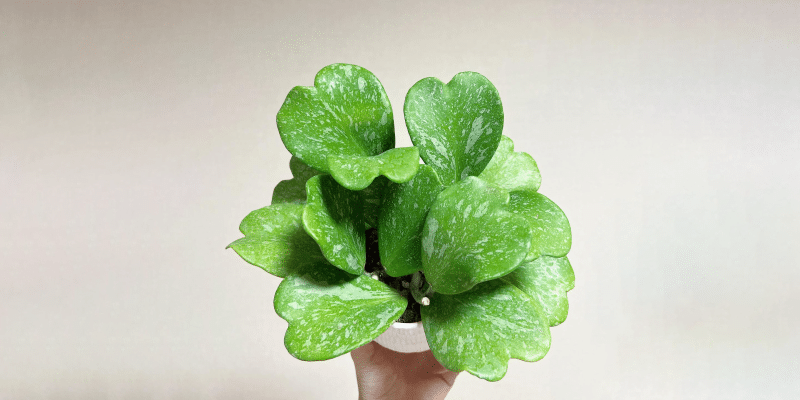Hoya Kerrii is an absolutely adorable succulent-like plant with heart-shaped leaves and just about the simplest care I can think of.
The ‘Sweetheart Hoya’ is a common gift during Valentine’s Day (they’re basically everywhere), and… honestly? It makes sense, they’re so pretty!
We’ll cover Hoya kerrii plant propagation, how to deal with the common issues that emerge, and answer the questions we see the most about Hoya kerrii care in this guide.
Let’s go!
Table of Contents
Hoya Kerrii Care Guide
History, habitat, and characteristics
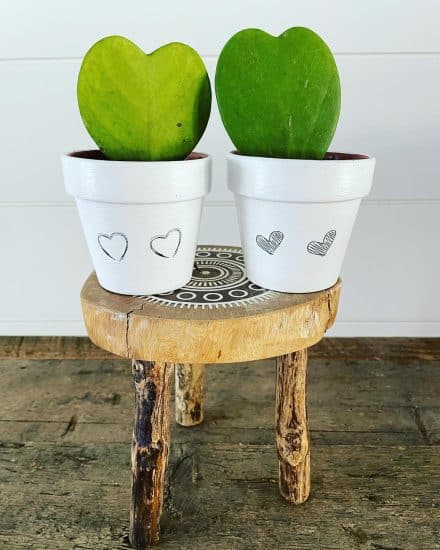
The history of Hoya kerrii is a romantic one, stretching back to the early 1900’s. We begin our journey in the Doi Suthep mountains west of Chiang Mai, Thailand. It was here that Arthur Francis George Kerr collected a specimen of this beautiful plant with heart-shaped leaves, naming it after himself, of course.
Self-love counts, right?
Hoya kerrii produces a near-perfect two-lobed heart, so it’s no surprise that it’s become a popular choice for Valentine’s day gifts, especially with its easy-care nature and almost over-the-top romantic symbolism.
But even before the romantic public discovered this delightful plant, Hoya kerrii thrived in its natural habitat as an epiphyte, climbing and clinging to the tall trees of Thailand. While not technically considered to be a succulent, its fleshy leaves could fool you with their ability to store plenty of water. This, coupled with a slow growth rate, makes it a great starter plant, especially in a hanging basket.
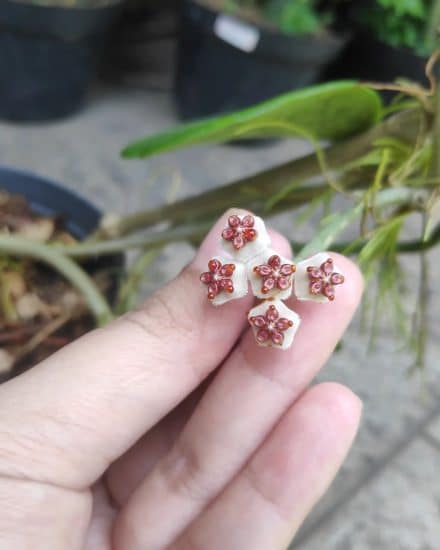
The graceful vines, the rolling hearts, and of course its captivating clusters of white and red flowers all dance together in perfect harmony.
Hoya kerrii, often referred to as the Sweetheart Hoya Plant or Valentine Hoya, features leaves with a thick, waxy texture. You’ll often see these for sale at garden centers, especially around Valentine’s Day, as a single heart-shaped leaf.
You may want to avoid these, as they can’t be propagated and will stop growing.
That’s right — unfortunately, Sweetheart hoya kerrii plants require a bit of the main stem for a cutting. Leaf cutting and other forms of propagation just don’t work.
Being a succulent-like plant, the Hoya kerrii likes to remain a bit thirsty and tends to do well wherever you decide to keep it. We’ll cover care in just a moment.
Types of Hoya Kerrii
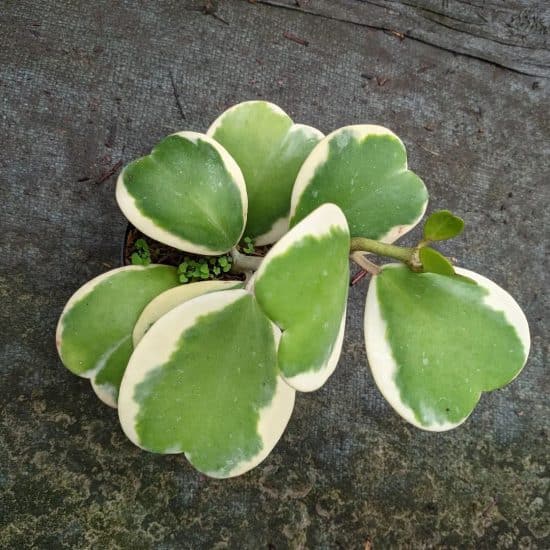
As far as varieties, a few popular types circulate:
Hoya kerrii ‘Veriegata’ – also known as sweetheart variegated hoya kerrii, these feature a dark green leaf at the center and light yellowish edges. They do require a bit more light due to their variegation, but otherwise are just as easy to care for.
Hoya kerrii ‘Reverse Variegata’ – These reverse variegated Hoya Kerrii are a bit rare and feature a true inversion of the variegation, with yellow-to-cream centers and dark green edges.
Single Leaf Hoya kerrii heart – This is the most common variety you’ll see in a store, typically around Valentine’s Day. Also known as a Valentine hoya, it’ll be a single leaf potted in soil. It won’t grow new leaves (or much at all), but with regular care, it’ll survive on its own. Maybe plant a second to keep it company?
Light
We all know the typical instructions for an indoor plant: lots of light, but keep it indirect. With indoor succulents, we often expect they’ll thrive in a variety of conditions.
Well: Sweetheart hoya is a beautiful exception. These plants absolutely love light. They can’t get enough of it. I mean that — you can even use direct light and scorch the leaves a bit, and they’ll grow even faster.
These plants love to be sunbleached and oversunned, so please take advantage of this and place them where other plants won’t thrive. Your south-facing windows just got some company, finally!
Water
You’ll hear me use the phrase “succulent-like” a lot in this article because it’s essential to understanding how to care for Hoya kerrii plants.
They adore being underwatered. Yes, be neglectful, I insist! 8-10 days is fairly standard, and you’ll notice they don’t like to go much longer than 2 weeks with most soil mixes.
If you do underwater your Hoya kerrii, the leaves will shrivel up a bit, and unfortunately, they will take some time to recover, but the plant will still be healthy and spring back to its former life.
Tips
- When you do water, give them a good drenching.
- If the soil is completely dry and you notice the leaves have lost some of their plumpness, it’s time to replenish their water.
- Avoid overwatering this plant. Really trust that they’re holding on to everything they need in those large, beautiful leaves.
- During the fall and winter season, reduce your watering frequency.
- Never let a pot sit full of water without draining. If your pot doesn’t have drainage holes: add them!
Temperature and humidity
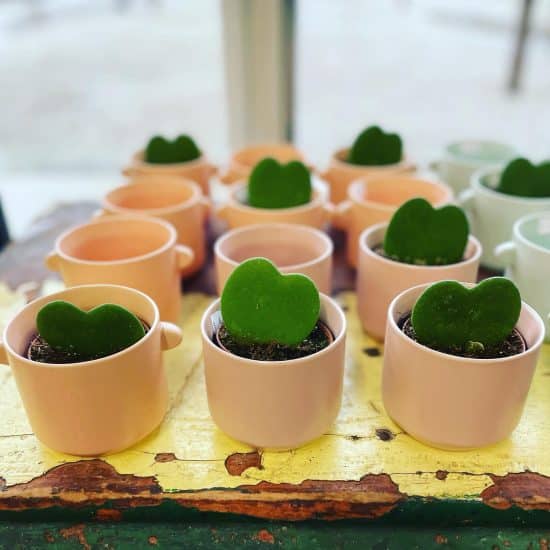
Are Hoya kerrii picky house guests? Absolutely not. They’ll basically take whatever you give them.
How wide of a range?
For temperature, they’ll actually be fine anywhere from 50 degrees (no colder, for either of you!) all the way up to 90 F. Much higher than that and you’ll have some difficulty, but they are pretty hardy (hearty?). If you want, you can even move these outside during their growing season.
For humidity, they actually are just as comfortable as you are with standard household humidity. More humidity means more growth, so you can add a pebble tray, other plants, or a humidifier if you aren’t seeing growth on your Valentine hoya. 40% or more humidity? This plant is loving you.
Soil and planting
I recommend a peat-based potting soil mix for Hoya kerrii plants. This is going to be a very well-draining soil so that you can really dunk them full of water and have the soil dry a few days later.
For a pot, terracotta is great because, again, big, succulent-like leaves, big, succulent-like care. They do not like to stay moist. Trust those leaves!
Fertilizer can be applied twice a year during the growing season, just make sure to dilute and water thoroughly after.
If you’re noticing slow growth or want to encourage a bloom, you can even give it a spray with orchid mist. It’s not essential, but slower growing hoyas tend to love it.
Propagation guide
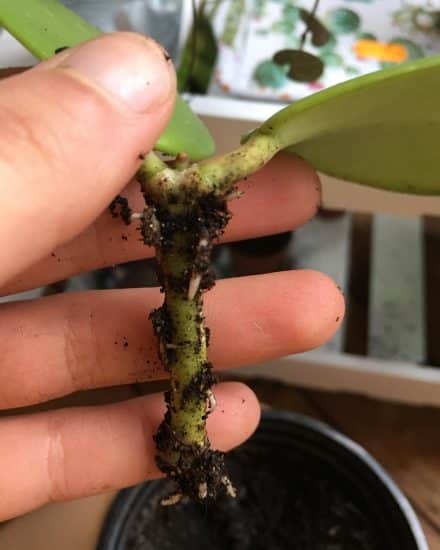
To propagate a Hoya kerri plant, you’ll need to take a stem cutting. While most Hoya kerrii plants are sold as leaf cuttings, they don’t form the main roots required to grow.
Water propagating Hoya kerrii by stem cutting
- You first need to find a stem with several nodes. If you look closely at the stem, you’ll see 2-3 small protrusions — this is a good candidate.
- Take pruning shears or sterilized (alcohol or boiling water) scissors, and cut the stem 3-4 inches below the node, so that when you replant, the leaf remains above the soil.
- Place the cutting in a jar of filtered water. Room temperature is ideal. Leaves should be above the surface.
- Place the jar in a well-lit space, changing the water every few days. In 2-3 weeks, you should notice a sturdy root structure. It’s time to plant in soil once the roots are a few inches long.
- Follow the soil guidelines in the section above, but make sure to keep it a little moister than usual for the first week or two. After that, regular care guidelines apply!
Hoya kerrii plants, especially variegated hoya kerrii, are not the fastest growers, so it’ll likely be a bit of time before you start seeing a mature plant emerging.
Common issues
A Hoya kerrii plant is super easy to care for, but it can succumb to all the same issues that indoor plants experience. Mostly due to taking a vacation and trusting a roommate. Just kidding… mostly.
We’ll first cover a unique issue with this plant that we find with the beautiful and elegant Single Leaf Hoya kerrii.
Single leaf Hoya Kerrii cuttings
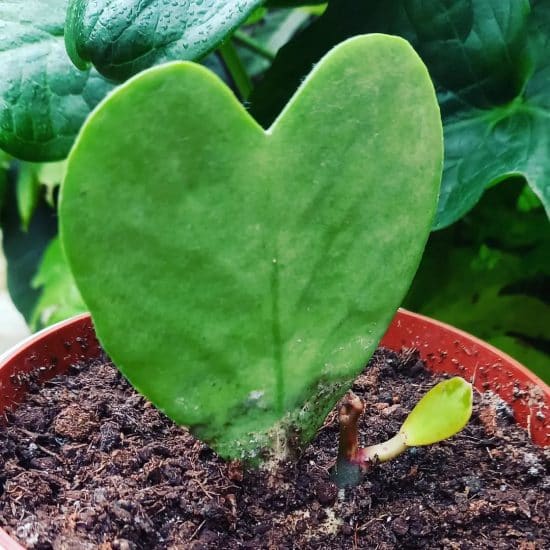
Typically around Valentine’s day, we’ll see a sweetheart plant sold as a single heart in a small pot. These are usually not cut from a main stem, so they will not grow unless they include a very small part of that stem.
I know some nurseries that experiment with taking these subtle main stem cuttings, but 99% of the single leaves sold generally won’t grow (unlike other succulents).
You can often purchase established mature plants for the same price (or cheaper), so go with one of those if you want new Hoya kerrii leaves to grow.
Otherwise: there’s absolutely nothing wrong with having one of these plants. For many, they’re a lot more manageable as single leaves, but don’t think something is wrong if you notice your single leaf isn’t showing new growth.
Yellowing Leaves
Whether you have one leaf or a cluster from a larger plant, yellowing leaves are just a fact of life for indoor plants. And just like other hoyas, they’re often more noticeable with the variegated versions.
Yellowing leaves are typically a sign of over-watering, too much full sun, or Hoya hearts that have been left wet for too long.
The fix: make sure your soil dries out, you give them plenty of indirect light, and excess water has somewhere to go with drainage holes.
Diseases and pests
Hoya kerrii plants really seem to attract mealybugs. I don’t know why. I’m not sure if it’s well-studied, but just about everyone I know with a Hoya kerrii has experienced this.
The good news? This is a thick plant, and its leaves really repel most pests. So while you might notice a lot of pests, they’ll tend not to do all that much. Just rinse them off or apply neem oil.
Root rot, on the other hand, is such a common issue that we should maybe have two sections about it in this article, one at each end. You’ll usually notice yellowing leaves that start dropping and a plant that sags.
You need to check out those roots and make sure to cut any that are brown/black and slimy off. Grab some fresh soil, a new pot (let the old one sit in bright light for a few days), and replant right away. Make sure to use well-draining soil that is allowed to fully dry, and root rot will be a concern of the past.
Conclusion
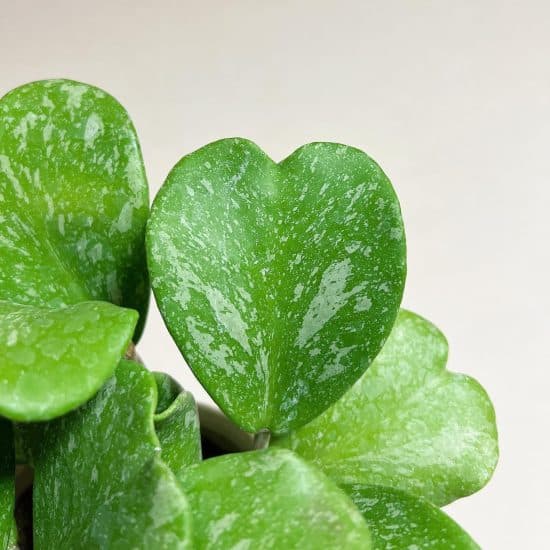
Hoya Kerrii is a beautiful succulent-like indoor plant that benefits from loads of light and just a little bit of water, and thrives in a wide range of temperatures and humidity conditions.
Caring for hoya kerrii couldn’t be easier for a beginner, so it makes a great gift for a friend (or partner!).
Your potting mix should be well-draining (use a pot with a drainage hole or two, and add perlite, LECA, or sand). Offer this slow grower warm temperatures and enough light, and you’ll soon see more than a few leaves start to emerge. It does like being a bit root bound, so take your time with repotting.
If you have any questions about propagation or care, or just want to show off some pretty variegation, drop us a line!
FAQ
Do sweetheart Hoya kerrii plants enjoy being rootbound?
They do! A Hoya kerrii plant thrives with a bit of neglect, whether it’s light, replanting, or watering. They have a lot in common with succulents.
How does care differ for a variegated Hoya kerrii?
Hoya kerrii care differs only with how much light they want. Variegated hoya kerrii plants benefit from even more indirect light and might fry a bit faster under direct sun.
When will Hoya Kerrii flower?
Hoya kerrii flowers typically will appear in the beginning of its growing season (March through June) and feature beautiful blooms of white and pink star-shaped clusters. You’ll notice beads of fragrant sap on the tips of these flowers. Just be aware that they’re very sticky and can produce a lot of pollen. It’s absolutely fine to clip these off, and doing so will encourage faster growth from your Kerrii.
Enjoy these beautiful flowers, they’re some of my favorite!
Can you use a grow light with Hoya kerrii?
You can. Make sure it’s full spectrum and LED to save on energy, but most people can get away with a north-facing window, even if it will lead to a slow-growing plant.
What’s the difference between a mature Hoya Kerrii plant and a young plant?
Unlike some plants, where the leaves dramatically change shape as they mature, the heart-shaped leaves of the Hoya Kerrii (sweetheart plant) stay throughout its life. If you do have a mature plant, you’ll notice this in its new growth too. New plants do benefit from a bit of extra nutrition in the soil, which can take the form of orchid bark.
How do you take care of a Hoya kerrii vine?
Pretty much the same as any other Sweetheart plant! After a few years of growth, you’ll notice more and more Hoya vines, so you can train them on a pole or just let them creep out of a hanging planter.

